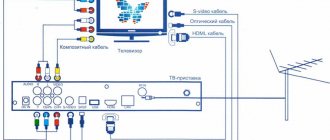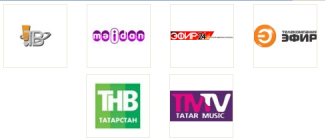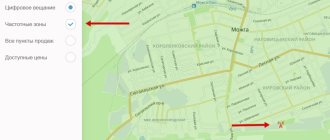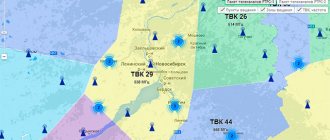Analog has been replaced by digital broadcasting. It is characterized by the transmission of graphic information in high quality. In practice, several formats operate in our country: cable, satellite, and terrestrial broadcasting.
The latter format has found particular popularity. Let's figure out what features the digital TV standard in Russia has. Let's look at them in more detail.
Are you satisfied with digital TV?
Yes, it is quite
26.67%
No, I'm not satisfied
73.33%
Voted: 30
What is digital TV?
The simplest answer to the first part of this question is television, broadcast by broadcasting a digital signal. The digital signal itself is data encoded in the form of zeros and ones, transmitted “dosed” in the form of blocks (for comparison, the analog signal is continuous). However, it cannot be said that analogue signals are not used in the digital television broadcasting system. In fact, without them nothing would work at all. The analog signal is the original one (if we consider terrestrial TV), which is simply encoded into zeros and ones by special equipment before being sent. But we will not consider all this technical side of the moment.
Due to the fact that “digital” is significantly different from “analog”, its reception also requires a special device - a digital-to-analog converter called a “TV tuner” or simply a “TV set-top box”. That, in turn, converts (decodes) the digital signal into a format that is “understandable” to the TV. We will definitely return to this issue a little later.
Standard definition vs high definition
Depending on the image resolution, digital TV is divided into SD (“standard definition”) and HD (“high definition”).
SDTV is a type of television broadcasting standard based on the 625/50 (576i) and 525/60 (480i) active frame resolution standards. Standard definition television uses a 4:3 screen format, close to the classic cinema format.
HDTV is a television broadcasting system with a resolution increased by 2 times compared to the standard one. The HD standard is a screen aspect ratio of 16:9 and a resolution of 1920x1080 pixels. High-definition television allows you to keep the line structure of the image invisible and the details clearly visible, thanks to which you can view the image from a closer distance or use a larger screen. In addition, multi-channel audio is expected to be transmitted in Dolby Digital quality.
Digital TV parameters in Russia
Digital television systems operate in accordance with television broadcasting standards. There are several of them. For reference, here are descriptions of the 4 most common standards:
- DVB-T and DVB-T2. These are European television broadcasting standards of the first and second generation, respectively. In Russia, as in most countries of the world, the DVB-T2 standard is used.
- ATSC. American digital TV standard. Used in the USA, Canada, South Korea and some Latin American countries.
- ISDB. Japanese standard "digits". In addition to Japan itself, it is also used in most countries of Central and South America, a few countries in Asia and Africa.
- DTMB. This is the youngest Chinese digital broadcasting standard. In addition to China, the standard has also been adopted in Pakistan, Laos, Cambodia, Cuba and some other countries. According to the Chinese themselves, DTMB surpasses all three previous standards in all respects.
Regarding the main parameters of the European DVB-T2 standard used in Russia:
- Broadcasting is carried out on meter (MV/HF) and decimeter (UHF/UHF) radio frequencies in the ranges 174...230 MHz and 470...790 MHz, respectively.
- Frequency channels reserved for broadcasting: 6…12 for the meter range and 21…60 for the decimeter range.
- Resolution of the transmitted video image: 720x576 pixels (i.e. video in SD quality).
Characteristics of the broadcast standard
Today, the European digital TV standard includes several formats:
- terrestrial broadcasting (DVB-T/T2);
- satellite broadcasting (DVB-S/S2/SH);
- cable broadcasting (DVB-C).
Each broadcast format is a separate way of compressing a signal into digital and requires a separate decoder to decrypt each of them.
Free digital TV channels available in Russia
Most of the TV channels broadcast today in Russia digitally are paid. Only 20 of them are available for free. All of them make up the list of “All-Russian mandatory public television channels.” These include: Channel One, Russia-1, Russia-24, Russia-K, Match TV, NTV, TV Center, Carousel, OTR, Channel Five, Muz-TV, REN TV, Spas, TNT, STS, Domashny, Mir, Star Friday! and TV-3.
The listed TV channels are broadcast throughout the Russian Federation. To view them you do not need to enter into any agreement with anyone. All that is required is a television receiver that supports digital TV (or equipped with a TV set-top box), and any (even homemade) decimeter or all-wave antenna (even that may not be needed).
Many Internet providers today offer access to many paid digital channels for free when concluding a contract for the use of Internet services. However, to view these channels, it is not an antenna that is used, but a computer network cable that is connected to a TV or set-top box. Often these TV channels can be accessed from a special mobile application or from the provider's website.
HDTV television in Russia In this article, we will try to conduct a short review of HD television operators, tell you what channels they provide for viewing and under what conditions. And also explain what High Definition Television is, what equipment is needed for full viewing in HDTV quality. “What is HD television?”, “Satellite television is high-definition television?”, “If we install a satellite receiver, will we watch television in digital quality and high definition?”, “What equipment must be purchased to watch HDTV channels, what receiver, what TV? These or similar questions are asked to us both by those who are preparing to make a choice of equipment and satellite operator, and by those who have already become subscribers of satellite television NTV-PLUS, TRICOLOR TV, Raduga TV, etc. All this led to the idea of writing an article to help you , to our valued clients. In this article we will try to briefly answer the following questions:
- What is HD television format, how does it differ from regular television?
- Which TVs can play HDTV format?
- What satellite equipment do I need to purchase to receive HDTV?
- Which television operators create program packages in high-definition television (HDTV) format?
- In what format are other channels received by conventional satellite receivers?
WHAT IS HD TELEVISION FORMAT, HOW IS IT DIFFERENT FROM REGULAR TELEVISION?
HDTV (High definition television) is an international digital standard with a higher resolution than the SECAM broadcast standard used by Russian television companies. Transmission standards The transmission of a HDTV video signal from a broadcast station to the end-user receiver is usually carried out in compressed digital form . The most commonly used format for encoding video signals into HDTV is .
- digital satellite television (, );
- digital cable television ();
- digital terrestrial (terrestrial) television ().
The HDTV signal is transmitted from the user's receiver to the display (TV) in uncompressed form through digital interfaces (cables) and. The use of digital interfaces allows you to completely get rid of digital-to-analog conversions along the entire signal path. Transmission formats The most popular formats of high definition standards:
- 720p: 1280×720 pixels, progressive scan, aspect ratio 16:9, frequency - 24, 25, 30, 50 or 60 frames per second (this HDTV format is recommended as the standard for member countries of the European Broadcasting Union);
- 1080i: 1920x1080 pixels, interlaced, 16:9 aspect ratio, 50 or 60 fields per second;
- 1080p: 1920x1080 pixels, progressive scan, 16:9 aspect ratio, 24, 25 or 30 frames per second.
Content protection Protection of image and sound from copying and modification is carried out using protocol technologies.
Standard transmission ( SD ) in the SECAM allows you to transmit a signal from the broadcast station to the subscriber's receiver either in analog or digital (MPEG-2 video encoding) form, with a resolution of 720x576px and an aspect ratio of 4:3. The connection to the television receiver is made via component analog interfaces (RGBHV and YPbPr). At the household level, such cords are called “SCART” or “tulip”.
To put it simply, the information content of an HD is 1920×1080=2,073,600 pixels on a TV screen, a SECAM is 720x576=414,720 pixels, that is, the resolution of HD is 5 times higher than that of regular SD.
WHAT TVS ARE CAPABLE OF PLAYING HDTV FORMAT? WHAT PARAMETERS SHOULD BE SELECTED AND CONSIDERED?
It is necessary to explain to you, our dear readers, that when choosing a TV you must be guided not only by the manufacturer, price, etc., but also be sure to take into account the functions associated with the further ability to watch HD channels and connect devices (DVD set-top boxes, cinemas, satellite receivers ) supporting HDTV standards. The main thing that:
- the TV must be labeled HD Ready or Full HD;
- have a digital input (preferably several) HDMI or DVI-D. We recommend giving preference to the HDMI input (it is more common and will not require additional costs for searching and purchasing adapter cables for pairing with other devices);
- HDMI or DVI-D digital inputs must support the HDCP protocol (this is necessary for compatibility when pairing with other HDTV devices, which most support this protocol). You need to know that many TV models already have built-in receivers (HD receivers) and if your choice falls on such a TV, pay attention to two things:
- What transmission standard is supported by the built-in receiver (DVB-S, DVB-T, DVB-C)? It’s just that in the Rostov region (and many others) there is no digital television yet, either over the air or via cable, and therefore built-in receivers of DVB-T, DVB-C standards are unlikely to be useful to you in the near future.
- If the built-in receiver supports the DVB-S transmission standard, then carefully look to see if it has a card reader? What access cards and in what encodings does it support? Is there a separate CI interface for installation?
WHAT SATELLITE EQUIPMENT DO I NEED TO PURCHASE TO RECEIVE HDTV?
The choice of satellite equipment often depends on the choice of satellite television operator. This is due to the fact that operators recommend using satellite receivers that not only support the HDTV standard, but also support access cards for receiving channels in a certain encoding. For example: - the operator PLATFORM HD recommends HDTV satellite receivers General Satellite HD 9300 and Humax HDCI 2000, which support DRE Crypt encoding, - the operator RICOR TV recommends HDTV models: RIKOR HD IVR 3100S, RIKOR HD IVR 5250S, RIKOR HD IVR 5750 and RIKOR HD IVR 5250S/1500, supporting Canax encoding, in turn, the NTV-PLUS operator guarantees correct operation for receiving an HD television package with only one model of the Thomson DSI-4000NTV satellite receiver that supports Viaccess encoding. But in general, it will be functional to purchase both a satellite and a receiver for cable and terrestrial television, capable of receiving an MPEG-4 video signal, having an HDMI or DVI-D output, as well as a CI interface slot for installing a CAM module.
WHICH TELEVISION OPERATORS CREATE PROGRAM PACKAGES IN HIGH DEFINITION TELEVISION (HDTV) FORMAT?
If we consider Rostov-on-Don and the Rostov region, where our company is located, then at the time of writing this article, we sadly state the fact that there is no HD television in cable television networks, and there is nothing to say about broadcasting. It is actually possible to watch High Definition TV channels only by purchasing satellite equipment for connecting to satellite HD television operators. What kind of operators are these and what channel content do they offer us in HDTV format? These are satellite television operators in HDTV format:
- NTV-PLUS HD - offers 6 HDTV channels + more than 70 channels in standard form, for 850 rubles. per month or 2 HDTV channels + 13 channels in standard form, without a subscription fee, but subject to the purchase of equipment recommended by NTV-PLUS for viewing the HD package. Read more about the software package of this operator here.
- HD PLATFORM – offers 12 HDTV channels + 23 enhanced quality channels designed for viewing on modern flat panel TVs. Improved broadcast quality is made possible by using the MPEG-4 compression format and high data rates for each channel of the DV package. This operator offers a complete package of programs for 12 months for 4,200 rubles, which is 350 rubles per month. Read more about the software package of this operator here.
- Continent TV - includes more than 70 popular Russian and foreign TV channels, including high-definition TV channels (HDTV). The subscriber will be able to create a television package independently, depending on his preferences. This makes Continent TV affordable television for Russian residents, regardless of income level. The cost of a television package of 33 TV channels is 99 rubles. per month, out of 50 TV channels - 199 rubles, 10 all-Russian TV channels will be available to the subscriber for free. Read more about the project here.
- RICOR TV - offers a package consisting of 52 channels (so far only one of them is an HDTV channel), for 499 rubles per month. But the main function for which a subscription fee is charged is not the number of channels, but the capabilities of ACTIVE TELEVISION. Read more about the program package of this operator and the active television function here.
- HD media – offers 3 open (non-encoded) high definition channels (HDTV) without any subscription fee. The main condition is the acquisition of any equipment that supports this format and a satellite antenna (“dish”) of the required diameter to enable high-quality reception of channels from the satellite. It should be noted that the HD media and RICOR TV program packages are transmitted from one satellite, and the satellite receiver for receiving programs from the RICOR TV package can functionally receive channels from the HD media package with HD quality. Read more about the software package of this operator.
WHAT FORMAT IS OTHER CHANNELS RECEIVED BY TELEVISIONS AND REGULAR SATELLITE RECEIVERS?
In almost all traditional terrestrial television formats, the aspect ratio of the picture is 4:3 , and in the Full HD (high definition) standard the aspect ratio of the picture is 16:9 , as a result of which the usual picture on HDTV TV (LCD TV or plasma TV) will be stretch across the entire screen, and the proportions on the screen will be distorted. But it is also possible to make the TV display empty black bars around the edges. It is also possible to enlarge the picture to fill the entire screen while maintaining the proportions, but in this case some parts of the picture will be cropped, that is, a little from the bottom and a little from the top. TV owners can independently choose how to display a standard 4:3 picture (SD) on an HD TV, that is, they can either crop the image at the top and bottom, or show the entire image, but with empty stripes on the left and right. However, on HDTVs, the Full HD image will have an aspect ratio of 16:9, which will give a full and undistorted picture. So what to do if satellite equipment has already been purchased, but the TV does not have HDMI or DVI ports? No need to be upset. You will simply receive a digital signal in SD format. This is also a digital signal, but of lower resolution compared to HDTV. And instead of the HDMI port, use the so-called “SCART” RGB port. Our only recommendation is not to buy a cheap (thin) connecting cable “SCART-SCART” or “SCART-Component”. A good cable that will not interfere or distort the signal, 1 m long, costs about 500-600 rubles. It is visually much thicker than the cheap one, costing 60-80 rubles.
If you listen to our recommendations and make the right choice by purchasing all the necessary equipment, then in the end you will really feel and notice the difference, and enjoy truly high-quality picture and sound!
Advantages and disadvantages of digital TV
Digital has many advantages over analog television, although there are also some disadvantages. The positive qualities of digital TV include:
- High picture and sound quality, incomparable to that of analog TV.
- Higher noise immunity with lower power consumption of signal transmitters.
- Possibility of transmitting several TV channels in the same frequency range (signal multiplexing). For reference: thanks to multiplexing, it was possible to free up many radio frequencies that were previously allocated for broadcasting certain TV channels. Now they are planned to be used to build cellular networks and for other purposes.
- Creation of interactive television systems in which the viewer can be provided with various “Recording TV programs” (using the equipment of the operator company) and others.
- Possibility of transmitting additional information along with the TV signal (for example, captions for films or a TV program).
- Ability to change audio tracks on the fly. A similar service is usually provided to viewers of pay TV channels, and is often used to change the translation language of films, TV series, etc.
- Wide possibilities in terms of editing broadcast TV programs in real time (for example, overlaying 3D graphics).
- The ability to broadcast on the same radio frequencies (also thanks to multiplexing) and other advantages.
Their disadvantages of digital television especially stand out:
- Shorter digital signal transmission distance (if we compare analog and digital transmitters of the same power). As a result, building a digital broadcasting network requires the use of a larger number of transmitting devices and, as a result, large financial investments.
- If the signal level is insufficient, the resulting picture seems to “break into pieces” (part of the image is completely or partially not visible), “freezes” (and after the “freezing”, the lost video/audio stream is lost, as a result of which the TV program seems to be fast-forwarded a few seconds), or disappears completely. In the case of analog TV, when the signal level is weak, visual interference occurs, sound deteriorates, etc., but the meaning of what is happening on the screen remains clear.
- Low resistance to electromagnetic fields observed during thunderstorms. If the television receiver is located at a considerable distance from the transmitter, then during a thunderstorm the signal may be completely interrupted.
- For owners of old TVs, it is necessary to purchase a TV set-top box. However, they are not very expensive.
Let us note one more controversial point (whether this is a disadvantage or not is up to you to decide). To fully enjoy the quality of digital TV, a regular TV will not do. Old television receivers (regardless of the characteristics of the set-top box) are simply not capable of displaying a video image in the quality in which the broadcast is being carried out. But in any case, the picture quality will not be worse than that of the “analogue”.
Digital TV tower map
When selecting the “Digital Broadcasting” and “Frequency Zones” parameters in the system, the interactive map is painted in different colors, and the user has access to viewing data on a particular tower. In order to find out more detailed information, you should click on the region of interest and a specific tower.
Users have access to information about:
- Location of repeaters;
- Frequency zones;
- Physical channel number;
- Number of operating multiplexes;
- Television and radio companies servicing a particular tower.
Map of digital television of the Moscow region
Digital broadcasting of RTRS of the first type in the capital of Russia is divided into many single-frequency zones, that is, each such zone involves broadcasting multiplexes on one frequency. For many residents of the capital, the main TV transmitter is the Ostankino Tower.
Open coverage map
For certain reasons, in particular due to buildings and terrain, a high-quality signal from this source cannot be obtained in all areas of the city. The solution to this problem is to redirect the antenna to the repeater.
The signal from these towers is much weaker than the signal transmitted by the Ostankino Tower; such towers operate at a certain frequency. Note that in order to find and correctly direct the UHF television antenna, the user can be helped by online map algorithms.
Map of digital television of the Leningrad region
At the beginning of December in the Leningrad region, the broadcast of the second package of channels began in some other regions. Until then, the second multiplex was available only to residents of Tikhvin, Vyborg, and Gatchina.
Open coverage map
Digital television coverage map of the Sverdlovsk region
Currently, residents of the Sverdlovsk region have access to channels that are included in the RTRS-1 package. It is expected that by the end of this year the Sverdlovsk region will have full access to the second multiplex. So far, RTRS-2 is broadcast in cities such as Asbest, Yekaterinburg, as well as Serov, Nizhny Tagil.
Open coverage map
Map of digital television of the Samara region
Until 2021, two packages of channels were broadcast in the Samara region from four towers - Samara, Chapaevsk, Syzran and Zhigulevsk. Since January of this year, 50 television towers located in the region also began broadcasting 20 channels.
Open coverage map
You can always find out about details for other regions of Russia through the interactive map system .
How to start watching digital TV?
It has been mentioned more than once that watching digital television requires equipment specially designed for this. The easiest way to start watching digital is to purchase a TV that supports the DVB-T2 television broadcasting standard . It is clear that many people cannot afford a new television receiver or simply do not need it. Fortunately, to watch digital TV channels you can purchase a set-top box (tuner), the price of which is much lower than the cost of a new TV. In addition to the television receiver itself, you may also need an antenna . This is especially true for those who live a considerable distance from the nearest television transmitter.
Let's consider all these points in more detail.
How do you know if your TV supports digital?
To determine whether your existing television receiver supports digital television, it is enough to study the technical documentation for it. In it you need to find information about the television systems (standards) supported by the TV. If “DVB-T2” is found in the documentation, this means that the TV receiver is suitable for digital reception.
If there is no documentation, you can try to find the “DVB-T2” designation somewhere on the body of the television receiver (usually where the cable sockets are located). But this is not the best way. Information about your existing TV can always be found on the Internet (for example, in one of the online stores or on the manufacturer’s website). You just need to enter its model into any search engine.
What to do if your TV does not support digital TV?
The answer is simple - purchasing a TV set-top box. With the transition to digital TV, tuners that allow receiving a digital signal of the DVB-T2 standard have flooded into the domestic market, so there should not be any difficulties in purchasing them. TV set-top boxes are now even sold in many post offices (this is especially true for settlements remote from large cities). The average cost of the simplest (without “bells and whistles”) TV set-top box is around 1,500 rubles. You can find it cheaper by visiting any of the existing Chinese online stores like Aliexpress.
A mandatory requirement that a TV set-top box must meet is support for the DVB-T2 standard. Please note that if the tuner was created for the first generation standard (DVB-T), it will not work.
Requirements for TVs
Depending on the year of manufacture, the equipment of televisions differs markedly. The latest TV equipment, like TVs released after 2013, contain a built-in DVB-T2 tuner. Its presence may be indicated by markings on the device or data from the technical passport. The corresponding inscription - DVB-T2 receiver - confirms that the device is suitable for receiving the DTV (Digital Television Transition) digital terrestrial television signal.
A TV with DVB-T2 is the most convenient option for connecting to a digital service using the new digital standard, and in this case you will not need to purchase a set-top box.
Television receivers manufactured before 2013 should be approached more carefully - most often they do not support the new generation format. The operating instructions will help you verify this. For such a TV you will need an antenna + DVB-T2 tuner-receiver with an HDMI or RCA cable connector. Any antenna designed to operate in the UHF range can be suitable.
Using an external DVB-T2 set-top box with a relatively low cost allows you to expand the capabilities of your existing TV and avoid the significant costs of purchasing a new one.
What kind of antenna is needed to receive a digital TV signal?
For digital reception, an all-wave or decimeter antenna is suitable. Exactly what characteristics it should have depends on the distance between the TV and the transmitting TV tower:
- From 3 to 10 km. The simplest indoor antenna without an amplifier will do (that is, it does not require a separate power supply). But in urban environments with dense buildings, it is better to use an outdoor antenna. In both cases, the antenna should be pointed towards the transmitter.
- From 10 to 30 km. For reliable signal reception, you will need an antenna with an amplifier, which can be installed in the house, but better - outside the window (in this case, you need to use an outdoor antenna).
- From 30 to 50 km. An antenna with an amplifier is also required. It will have to be installed outside and as high as possible.
In apartment buildings, publicly accessible (collective) decimeter antennas have already begun to be installed, which are capable of providing all residents with a high-quality signal. In this case, a cable must be lowered into the apartment from the roof, which just needs to be connected directly to the TV.
Installation and direction of the antenna for terrestrial television of the new generation
The innovative standard on the territory of the Russian state is DVB-T2. To enjoy viewing the content provided by RTRS-1 and RTRS-2, citizens of the Russian Federation will need the following equipment:
- UHF antenna
- TV that supports DVB-T2 module
- Digital receiver (for owners of TVs that only support DBV-T)
To receive digital signals, you must have an indoor or outdoor decimeter antenna. For correct operation, point the antenna towards the repeater, the data of which can be found in the interactive map discussed earlier.
Experts advise installing a digital antenna on a windowsill, as this will allow you to achieve a high level of signal reception. Make sure there are no radio signal sources nearby as they will cause interference.
Interestingly, the presence of a multi-story building nearby does not mean that you are unlucky and because of this the signal will not be strong enough. High-rise buildings can also act as a signal reflector, on the contrary, positively influencing its power.
Installing an antenna under a metal roof can negatively affect the signal strength. When installing an outdoor antenna, care should be taken to install it firmly. Adjust the position of the antenna, guided by the technical data that is assigned to the tower that is closest to you - the exact location of the repeater, the distance to it, and the broadcast frequency can be found out thanks to the interactive map system.











